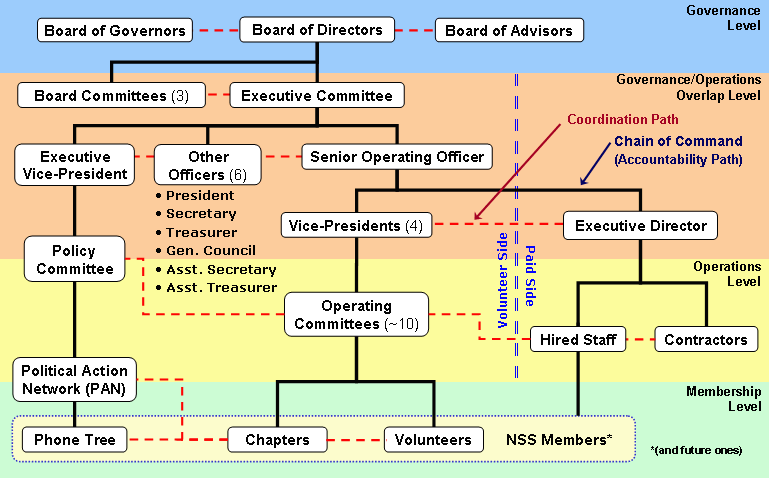The National Space Society: organizational inertia and term limits
02/10/13 21:26:00
By Michael Mealling
As the current president of the Georgia Space Society and a National Space Society member I was dismayed to hear that my friend Paul Damphouse resigned as NSS Executive Director and Board member effective February 15th.
What I'm going to say here is in no way meant to disparage any of the volunteers personally or to suggest that anyone is acting in bad faith. But when people like Paul leave after one year, membership is dropping, and financial problems persist year after year, it indicates that something somewhere is badly broken. I have some theories.
Regardless of what one things about organizational methods, organizational charts can tell you a lot about what is viewed as important by the people who run it. Here is the National Space Society's organizational chart:

In this case the Executive Director is three layers removed from the Board, coordinates with 6 vice-presidents, has no direct access to the Executive Vice-President or any of the Operating Committees. As you can imagine the volunteer side is reluctant to give any control or capability to the paid side. Can anyone expect an organization like that to work? It has 20 operating committees (there are even two separate Interent committees: Interent Services Committee and the Web Oversight Committee). For crying out loud, why?
In contrast lets look at an organization that also has 'members', is almost entirely run by volunteers and accomplishes mighty things with this structure. The Internet was designed by a small set of organizations: The Interenet Society, the Internet Architecture Board, the Internet Engineering Steering Group, and the Internet Engineering Task Force. They follow this structure:

Very clean and clear. No leadership outside of the pink box is paid (except for some support staff, IIRC). Everything is done in the IETF and IRTF. There are no dues and membership is completely open to anyone in the world who can join a Working Group mailing list. Sure, politics abound, but they rarely ever affect the organization or the processes. They run conferences three times a year (one is international) and they run like clockwork. And they do it without voting. They hum.
From rumor and legend one of the reasons the National Space Society is structured this way is because of remnants of the National Space Institute and L5 merger that created it. Another is that in such a marginal volunteer run organization you want to reward initiative with responsibility. Anyone willing to do something gets immediately shoved into a leadership role, even if a role doesn't exist. The other may be an inability to implement term limits. In the IETF many roles have term limits. Remove the temptation to reward past service by leaving people in stagnant roles by creating rules that require roles to rejustify themselves every two years.
Can the National Space Society be fixed? Organizational behavior suggests that it won't fix itself without some outside forcing process. It may need professional help. Let's hope it can survive.
comments powered by Disqus
